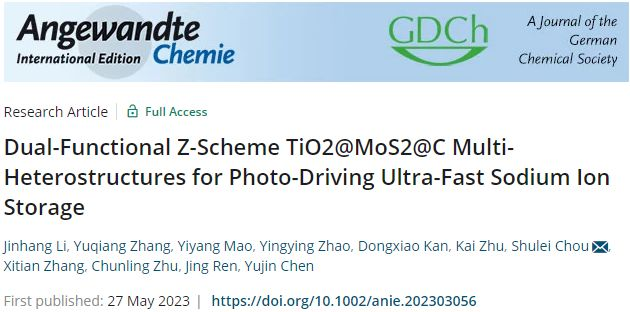Recently, the micro-nano photoelectric materials and devices research group of the College of Physics and Physics and Optoelectronic Engineering of our school constructed a dual-function photoelectrode with both photoelectric conversion interface and electronic transmission interface, successfully realized the solar charging sodium ion battery, and elaborated the dual-function photocell energy storage mechanism under light, providing a theoretical basis for the application of energy storage semiconductor materials in the field of photocell energy storage.
The research results were published in Angewandte Chemie International Edition, a top international academic journal, under the title “Bi-functional Z-type TiO2@MoS2@NC multi-heterostructure for Photodriven ultrafast sodium ion storage”. This is the first time for our school to publish academic results in this journal as the first unit, achieving a new breakthrough in the publication of results in the top academic journals in the field.

The efficient use of solar renewable and clean energy is an effective way to achieve sustainable development. However, intermittent solar energy conversion and storage usually connect the solar cell to the energy storage system, which not only increases the cost and energy loss of the system, but also has the problem of mismatch between the output voltage of the solar cell and the input voltage of the energy storage system. Therefore, the development of dual-function photocells that take into account both solar energy absorption and energy storage has become a hot spot in current research.
As the core of photocell, bifunctional photoelectrode not only has excellent visible light absorption, efficient photogenerated carrier separation and transport characteristics, but also has the characteristics of high capacity, high electrochemical stability and fast dynamics as energy storage materials. Based on this, the research group constructed a photoelectrode material with bifunctional characteristics by atomic layer deposition and anion exchange strategy, and realized the first solar-rechargeable sodium-ion battery.

▲Schematic diagram of the principle of a light-rechargeable sodium-ion battery and the electrochemical performance of the battery under dark and light conditions.
In the course of the experiment, the thorny problems such as the oxidation deterioration of the negative electrode caused by the battery packaging problem and the battery break caused by the conductive glass have a certain impact on the subject. In order to successfully assemble the photocharged sodium-ion batteries that meet the requirements, Professor Chen Yujin, Dr. Zhao Yingying and Li Jinhang analyzed the problems one by one and proposed a variety of practical solutions. After repeated experiments, they finally successfully assembled a photocell with excellent electrochemical performance. The research results break through the traditional indirect solar energy conversion and storage, and successfully realize the integrated optical storage and charge technology of solar cells. The technology has the advantages of simplifying device structure and reducing cost, effectively avoiding additional energy loss, and is expected to provide technical support for China to achieve the strategic goal of dual carbon and create a green intelligent society. The successful application of this technology also provides a new strategy for solar charging equipment, which is an ideal power source for aerospace and other fields.

▲Dr. Zhao Yingying instructs students to assemble photocells.

▲All teachers and students of micro and Nano optoelectronic materials and Devices research group
The “German Journal of Applied Chemistry” is a leading journal in the field of chemistry, with papers that focus on originality, importance of results, accessibility of content and scientific correctness. The journal is a JCR Region 1 with a 2022 impact factor of 16.823.
